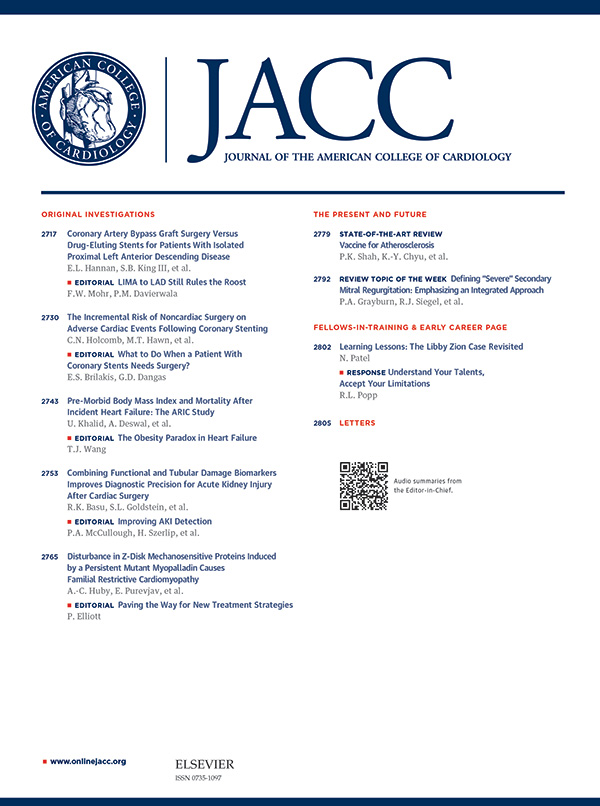Heart Failure Risk Assessment Using Biomarkers in Patients With Atrial Fibrillation
IF 21.7
1区 医学
Q1 CARDIAC & CARDIOVASCULAR SYSTEMS
引用次数: 0
Abstract
Background
Heart failure (HF) is common among patients with atrial fibrillation (AF), and accurate risk assessment is clinically important.
Objectives
The goal of this study was to investigate the incremental prognostic performance of N-terminal pro–B-type natriuretic peptide (NT-proBNP), high-sensitivity cardiac troponin T (hs-cTnT), and growth differentiation factor (GDF)-15 for HF risk stratification in patients with AF.
Methods
Individual patient data from 3 large randomized trials comparing direct oral anticoagulants (DOACs) with warfarin (ARISTOTLE [Apixaban for Reduction in Stroke and Other Thromboembolic Events in Atrial Fibrillation], ENGAGE AF-TIMI 48 [Effective Anticoagulation With Factor Xa Next Generation in Atrial Fibrillation–Thrombolysis In Myocardial Infarction 48], and RE-LY [Randomized Evaluation of Long-Term Anticoagulation Therapy]) from the COMBINE-AF (A Collaboration Between Multiple Institutions to Better Investigate Non-Vitamin K Antagonist Oral Anticoagulant Use in Atrial Fibrillation) cohort were pooled; all patients with available biomarkers at baseline were included. The composite endpoint was hospitalization for HF (HHF) or cardiovascular death (CVD), and secondary endpoints were HHF and HF-related death. Cox regression was used, adjusting for clinical factors, and interbiomarker correlation was addressed using weighted quantile sum regression analysis.
Results
In 32,041 patients, higher biomarker values were associated with a graded increase in absolute risk for CVD/HHF, HHF, and HF-related death. Adjusting for clinical variables and all biomarkers, NT-proBNP (HR per 1 SD: 1.68; 95% CI: 1.59-1.77), hs-cTnT (HR: 1.39; 95% CI: 1.33-1.44), and GDF-15 (HR: 1.20; 95% CI: 1.15-1.25) were significantly associated with CVD/HHF. The discrimination of the clinical model improved significantly upon addition of the biomarkers (c-index: 0.70 [95% CI: 0.69-0.71] to 0.77 [95% CI: 0.76-0.78]; likelihood ratio test, P < 0.001). Using weighted quantile sum regression analysis, the contribution to risk assessment was similar for NT-proBNP and hs-cTnT for CVD/HHF (38% and 41%, respectively); GDF-15 provided a statistically significant but lesser contribution to risk assessment. Results were similar for HHF and HF-related death, individually, and across key subgroups of patients based on a history of HF, AF pattern, and reduced or preserved left ventricular ejection fraction.
Conclusions
NT-proBNP, hs-cTnT, and GDF-15 contributed significantly and independently to the risk stratification for HF endpoints in patients with AF, with hs-cTnT being as important as NT-proBNP for HF risk stratification. Our findings support a possible future use of these biomarkers to distinguish patients with AF at low or high risk for HF.
使用生物标记物评估心房颤动患者的心衰风险:COMBINE-AF 分析
背景:心力衰竭(HF)在心房颤动(AF)患者中很常见,准确的风险评估在临床上非常重要:本研究旨在探讨 N-末端前 B 型利钠肽 (NT-proBNP)、高敏心肌肌钙蛋白 T (hs-cTnT) 和生长分化因子 (GDF)-15 对房颤患者心力衰竭风险分层的增量预后效果:直接口服抗凝剂(DOACs)与华法林比较的 3 项大型随机试验(ARISTOTLE [阿哌沙班减少心房颤动患者中风和其他血栓栓塞事件]、ENGAGE AF-TIMI 48 [心房颤动患者使用下一代因子 Xa 有效抗凝-心肌梗塞溶栓 48]、RE-LY [心房颤动患者使用下一代因子 Xa 有效抗凝-心肌梗塞溶栓 48])中的患者个体数据、和 RE-LY [长期抗凝疗法的随机评估])的患者进行汇总;纳入所有基线生物标志物可用的患者。综合终点是因房颤住院(HHF)或心血管死亡(CVD),次要终点是HHF和房颤相关死亡。在对临床因素进行调整后采用了Cox回归,并使用加权量子和回归分析解决了生物标记物之间的相关性问题:在32041名患者中,生物标志物值越高,心血管疾病/高血压、高血压和高血压相关死亡的绝对风险越高。对临床变量和所有生物标志物进行调整后,NT-proBNP(每 1 SD HR:1.68;95% CI:1.59-1.77)、hs-cTnT(HR:1.39;95% CI:1.33-1.44)和 GDF-15(HR:1.20;95% CI:1.15-1.25)与 CVD/HHF 显著相关。加入生物标志物后,临床模型的区分度明显提高(c-指数:0.70 [95% CI:0.70]):0.70[95%CI:0.69-0.71]至0.77[95%CI:0.76-0.78];似然比检验,P <0.001)。使用加权量子和回归分析,NT-proBNP 和 hs-cTnT 对心血管疾病/HHF 风险评估的贡献相似(分别为 38% 和 41%);GDF-15 对风险评估的贡献具有统计学意义,但较小。对于HHF和HF相关死亡,单个结果以及基于HF病史、房颤模式、左室射血分数降低或保留的关键亚组患者的结果相似:结论:NT-proBNP、hs-cTnT 和 GDF-15 对房颤患者的房颤终点风险分层有显著的独立作用,其中 hs-cTnT 与 NT-proBNP 对房颤风险分层同样重要。我们的研究结果支持将来可能使用这些生物标记物来区分房颤患者的房颤低危或高危风险。
本文章由计算机程序翻译,如有差异,请以英文原文为准。
求助全文
约1分钟内获得全文
求助全文
来源期刊
CiteScore
42.70
自引率
3.30%
发文量
5097
审稿时长
2-4 weeks
期刊介绍:
The Journal of the American College of Cardiology (JACC) publishes peer-reviewed articles highlighting all aspects of cardiovascular disease, including original clinical studies, experimental investigations with clear clinical relevance, state-of-the-art papers and viewpoints.
Content Profile:
-Original Investigations
-JACC State-of-the-Art Reviews
-JACC Review Topics of the Week
-Guidelines & Clinical Documents
-JACC Guideline Comparisons
-JACC Scientific Expert Panels
-Cardiovascular Medicine & Society
-Editorial Comments (accompanying every Original Investigation)
-Research Letters
-Fellows-in-Training/Early Career Professional Pages
-Editor’s Pages from the Editor-in-Chief or other invited thought leaders

 求助内容:
求助内容: 应助结果提醒方式:
应助结果提醒方式:


